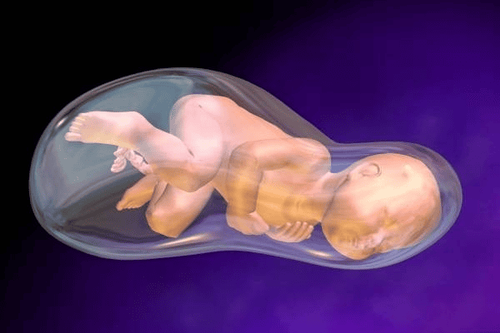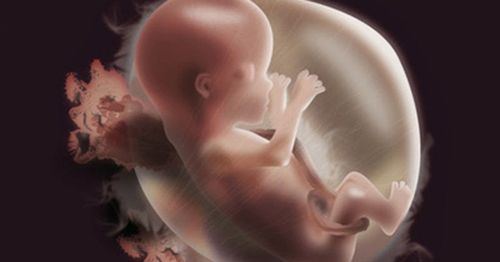This is an automatically translated article.
The article is written by Master, Doctor Phung Thi Ly - Department of Obstetrics and Gynecology - Vinmec Times City International Hospital.1. What is polyhydramnios?
Polyhydramnios is an excess accumulation of amniotic fluid. Amniotic fluid is the fluid that surrounds the fetus after the first few weeks of pregnancy. During most of pregnancy, amniotic fluid is derived almost entirely from the fetus, which helps to protect the fetus from injury in the womb, has antibacterial properties thus protecting the fetus from infection. It also helps in lung development. And especially, it acts as an environment containing fluids and nutrients for the fetus, supporting the fetus to maintain a stable and appropriate body temperature. This amount of fluid will gradually increase until about 1 liter at 37 weeks. After that, the amount of amniotic fluid usually drops to about 0.5 liters by 40 weeks of pregnancy. Your baby will regularly swallow amniotic fluid, which then passes out of the body as urine. This is the body's way of controlling the amount of amniotic fluid around the fetus. Once this balance is disturbed, the volume of amniotic fluid can increase rapidly, making pregnant women feel heavy and uncomfortable. At that time, polyhydramnios is usually diagnosed when the amniotic fluid volume is up to 2 liters or more. In severe cases, up to 3 liters of fluid may be present, three times the normal amount. To diagnose polyhydramnios, your doctor will perform an ultrasound and obtain an indirect estimate of the amniotic fluid volume. Mother was diagnosed with polyhydramnios when the amniotic fluid index (A.F.I) on ultrasound was more than 25 cm.Trắc nghiệm: Bạn có hiểu đúng về dấu hiệu mang thai sớm?
Các dấu hiệu mang thai sớm không phải chỉ mỗi trễ kinh mà còn có rất nhiều dấu hiệu khác như xuất huyết âm đạo, ngực căng tức,… Điểm xem bạn biết được bao nhiêu dấu hiệu mang thai sớm thông qua bài trắc nghiệm này nhé!
2. Where does polyhydramnios come from?
Amniotic fluid is a waste product from the fetus's kidneys. Fluid enters and leaves the baby's lungs and stomach in a continuous and closed cycle of regeneration. After the fluid enters and passes through the digestive tract, it is excreted by the kidneys, which is then recycled again and the cycle repeats. With this mechanism, the amount of amniotic fluid is always maintained, not too little or too much during the mother's pregnancy. If the amount of amniotic fluid is too high and won't correct itself, both mother and baby will experience some serious problems. In fact, in about two-thirds of cases of polyhydramnios, no cause can be found. Causes of maternal polyhydramnios can be due to:Maternal diabetes: Polyhydramnios is detected in 10% of pregnant women with diabetes, especially in the third trimester of pregnancy. When you have diabetes and your blood sugar is not well controlled, your baby may produce more urine. Therefore, lowering your blood sugar will reduce the amount of amniotic fluid. Pregnant women with dystonia. However, this is quite rare during pregnancy. Mothers carrying twins or multiples: Polyhydramnios can occur because the metabolism between the two fetuses is not balanced (one fetus has less amniotic fluid while the other has more amniotic fluid). Abnormalities in the fetus: The baby will stop the process of drinking amniotic fluid - urinating, leading to an excess of amniotic fluid. This condition occurs when malformations in the fetus such as cleft palate, pyloric stenosis... Other factors that may increase polyhydramnios are: Anemia in the fetus; fetal infection, blood type incompatibility between mother and baby...
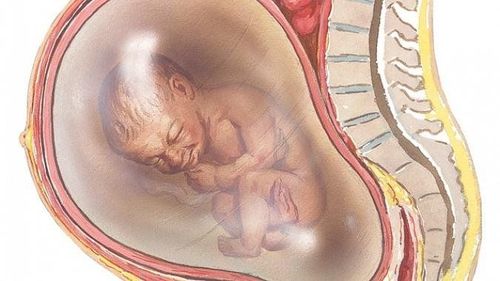
3. Is polyhydramnios dangerous?
The earlier polyhydramnios occurs in pregnancy and the higher the amount of amniotic fluid, the greater the risk of complications. Here are some risks that pregnant women may face when having polyhydramnios:When the amount of fluid in the uterus is too high, the mother will be at risk of premature rupture of membranes. other benefits for the mother Placental abruption Prolapse of the umbilical cord The growth and development of the fetus is restricted, and there are problems with skeletal development. To be on the safe side, the mother needs a cesarean section and therefore has an additional risk compared to a vaginal birth, possibly having postpartum infections. The baby is born prematurely, so the organ functions are not perfect, maybe the mother will be given steroids to help the baby's lungs mature faster. Mothers with polyhydramnios are more likely to experience bleeding or spotting after giving birth. This is because the uterus is compressed due to the large amount of amniotic fluid and cannot fully contract as usual. Stillbirth, this is the worst case scenario that can happen. In fact, there are usually no complications in the majority of cases of polyhydramnios. Of course, these risks vary depending on the severity and cause of polyhydramnios. As soon as the baby is born, the excess fluid is also drained and the mother feels more comfortable immediately.
4. What to do when having polyhydramnios?
In most cases of mild hyperhydramnios there is nothing to worry about. Your doctor will tell you to have regular checkups and give you some diuretics. If the cause of the infection can be determined, it can be treated with antibiotics that are safe for the fetus.For severe polyhydramnios, there are signs of problems related to the fetus that need to be monitored. Your doctor will closely monitor your amniotic fluid volume, if it increases too quickly you may need surgery, amniocentesis to remove the amniotic fluid.
In addition, pregnant women need to regularly visit for monitoring, even hospitalization and immediate intervention when necessary when symptoms such as shortness of breath or chest tightness appear; Abdominal enlargement rapidly and markedly, sudden pain.
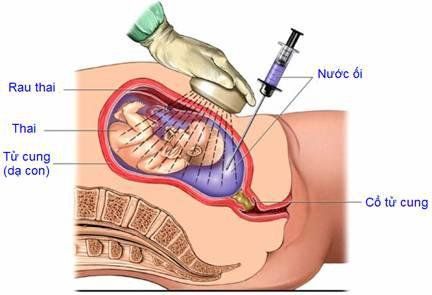
5. Other Notes
Mothers during pregnancy should have regular antenatal check-ups. When there are any concerns about yourself or your baby: Irritability, difficulty breathing or not breathing or your belly is suddenly large, skin is tight and shiny, swelling in the lower extremities, sometimes uterine contractions, symptoms of heartburn, indigestion, constipation, ... you should immediately see a doctor for timely examination and treatment.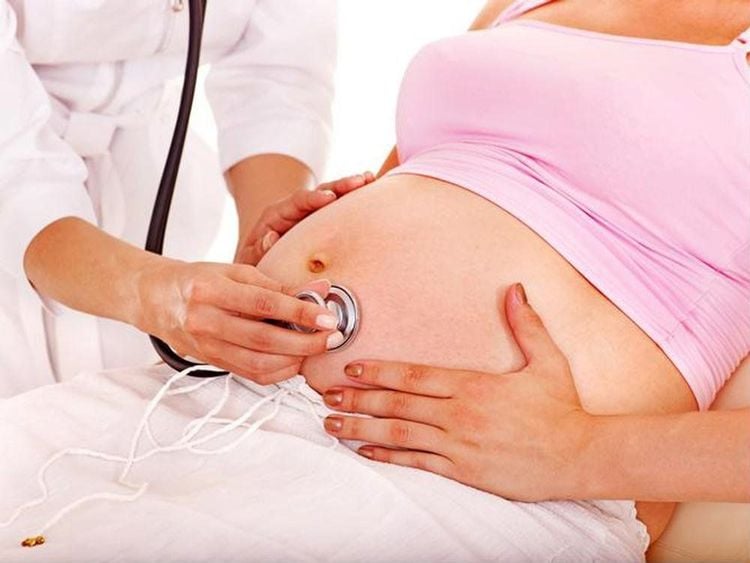
Note the nutrition during pregnancy. Don't worry too much: Remember that polyhydramnios is not a sign of something serious Rest regimen: Give yourself more time to relax. If you work, you might consider starting your maternity leave early to ensure the safety of both you and your baby. Acute polyhydramnios usually occurs at 16 - 20 weeks of pregnancy, so to ensure the health of both mother and baby, in the second 3 months of pregnancy, pregnant women need to pay attention:
Comprehensive fetal malformation screening by Superior 4D ultrasound technique. Screening for gestational diabetes, avoiding many dangerous complications for both mother and baby. Control the mother's weight reasonably to assess the health status of the pregnant woman and the development of the fetus. Understand the signs of threatened early delivery (especially in those carrying multiple pregnancies or having a history of miscarriage or premature birth) so that they can receive timely treatment to maintain pregnancy. To protect mother and baby during pregnancy, Vinmec provides a comprehensive Maternity service to monitor the health status of mother and baby, periodical antenatal check-ups with leading Obstetricians and Gynecologists. enough tests, important screening for pregnant women, counseling and timely intervention when detecting abnormalities in the health of mother and baby.
For detailed information about all-inclusive maternity packages, please contact the hospitals and clinics of Vinmec health system nationwide or register online on the website.
Please dial HOTLINE for more information or register for an appointment HERE. Download MyVinmec app to make appointments faster and to manage your bookings easily.





